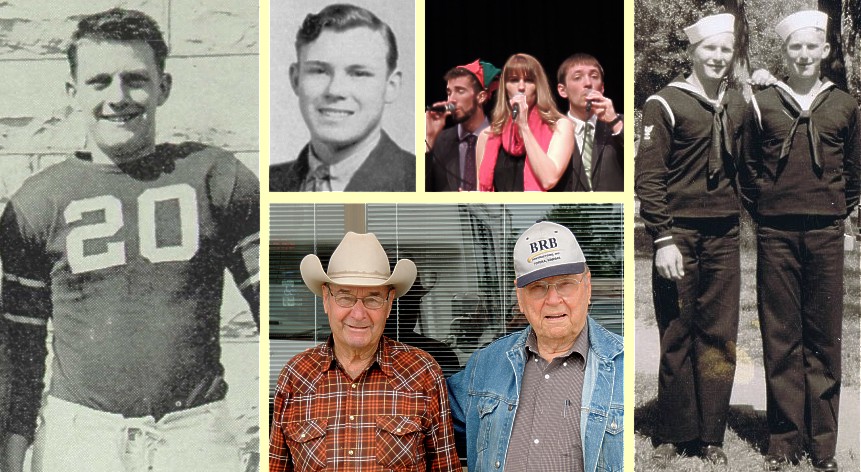
Left: Robert Srack in his football uniform; center-left-top: Harry Gehrt's senior picture; center-right-top: Xan Perkins, left, Katie Vaughan and Zach Button, three members of In-A-Chord, perform at the Peace Memorial Auditorium in December 2013; center-bottom: Buck Gehrt, left, with friend Jim Sharp. Sharp is a Battle of the Bulge veteran and auditorium activist; right: Forest, left, and Elmer Ebaugh.
-
Allen, Arthur M., Jr.
Armstrong, Gerald D.
Barry, Marvin D.
Barton, Henry L.
Bayles, Ben
Buckner, Eldon
Burson, Charles J., Jr.
Caine, Douglas K. Jr.
Callahan, Leslie J.
Campbell, Forrest B.
Carlson, Arnold V.
Caster, Arthur
Chapman, Donald J.
Coffman, William J.
Corporan, Emerson W.
Crumpton, Earl
Crumpton, Elmer R.
Davenport, Leo M.
Dobson, Claude W.
Dougherty, James G.
Dresser, Francis H.
Ebaugh, Elmer M.
Ebaugh, Forest V.
Edwards, Robert E.
Ehlers, Roland A.
Eichman, Coleman J.
Emmot, Valley V.
Englebert, Leo E., Jr.
Eslinger, Lawrence H.
Evans, Kendall
Fairman, Charles E., Jr.
Fleenor, Beattie
Fulton, Donald A.
Gehrt, Harry W.
The 101
Glenn, Richard C.
Gould, Phil
Green James M.
Hagenmaier, Ralph C.
Haines, Charles M.
Hale, Edgar Leighton
Hanna, Joe Kermit
Harris, Ernest Orville
Hinrichs, Clyde
Holland, Boyd F.
Hollis, James A., Jr.
Holstrom, Chester
Hotchkiss, Richard E.
Hugos, Francis Neal
Hulse, Earl R.
Hunt, Wesley Harold
Hyres, Paul H.
Immenschuh, Gilbert
Inskeep, George N.
Jaccard, Richard A.
Johnson, Dale E.
Johnson, Samuel Loy
Joss, Vincent S.
Kilkenny, John P., Jr.
Kratochvill, William M.
Lovell, Roy C.
Miller, Joseph Dale
Mills, Charles L.
Minton, Alfred L.
Mitchell, LeRoy
Morehead, Jesse E.
Murphy, Lyle M.
Nesbitt, Edwin S.
Newell, Ralph
-
Nicholes, John W.
Niemeier, Norman, F., Jr.
Nonamaker, Harold L.
Parizo, Charles H.
Payne, Jerry Bryan
Pearson, Paul E.
Powell, Glenn
Ramey, Roger Dean
Rankin, Ralph T.
Reid, James K.
Richards, Forrest F.
Root, Frank P., Jr.
Schneider, Waldo B.
Shadwell, Marion R.
Spence, Dean
Srack, Robert W.
Steere, Raymond J.
Stevenson, Frank J.
Stiverson, James
Suttle, Dale E., Jr.
Thomas, Joseph C.
Toburen, Emerson L.
Trotter, Robert T.
Van De Walker, Gene D.
Van Doren, Lyle R.
Van Winkle, Richard J.
Vathauer, Neale H.
Wands, Dixson I.
Webster, Wayne E.
Wertz, Oscar Leland
Whitacre, Elden L.
Winn, William
Zarger, Grant O.
Comments? [email protected].
Other columns from this year may be found at: Current year Index.
Links to previous years are on the home page: Home